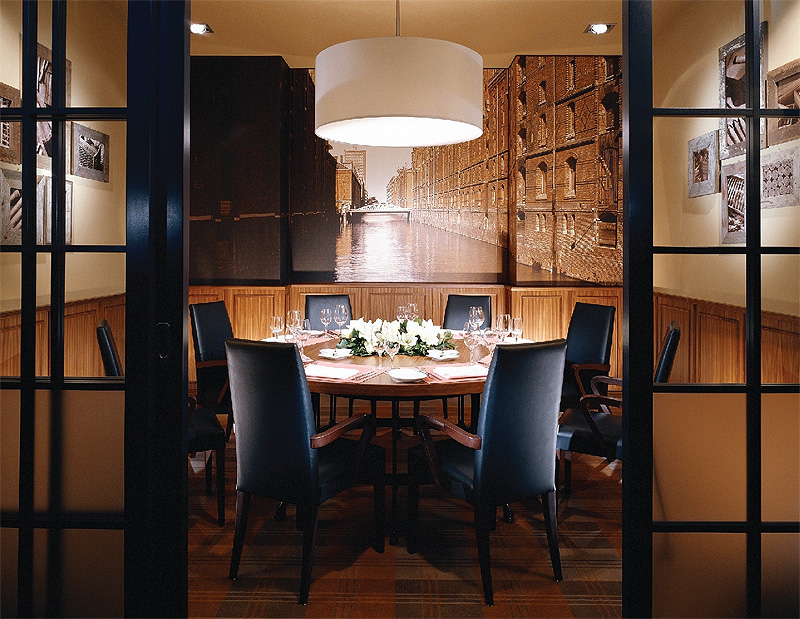
Hamburg Marriott
Centre of attention
The Hamburg Marriott is a popular hotel with an equally popular restaurant, and recent investment has allowed the company to upgrade its facilities
Located at the heart of one of Europe’s most vibrant and visited cities, the Hamburg Marriott Hotel is a 278-room hotel that opened in 1988 as the Marriott brand’s first presence in Germany. Over the last few years the building has gone through a number of renovations, including an overhaul of its restaurant and the complete refurbishment of its living facilities. As part of the international Marriott group, the hotel carries a respected quality that its customers are able to rely on.
Despite the Marriott brand, the hotel is not run as a carbon copy of other establishments in the chain; this is best exemplified by the restaurant’s renovation which not only saw it modernised but also localised. Named Speicher 52 after Hamburg’s landmark Speicherstadt – a warehouse district that has become a tourist attraction – the restaurant specialises in local cuisines with added spices, reflecting the Speicherstadt’s role in the spice trade.
Madeleine Marx, marketing director, highlights the hotel’s dining facilities as a point of pride for the business: “The idea we have with the Hamburg Marriott is that we position our restaurant as a separate entity to the hotel. We don’t want Speicher 52 to be a typical hotel restaurant, but rather a place where you can experience something local and special. We attract diners that are guests of the hotel and the city locals as well with an atmosphere that reflects the Speicherstadt.”
Speicher 52 has exposed brick walls, and displays photographs of spices, tea, and the historic Speicherstadt buildings and its surrounding canals. Its more modern styling means brighter colours, wider spaces and a lighter interior than its previous design. Most importantly, however, is the kitchen’s speciality in north German cuisine with its current head chef, Christine Zoch-Verhoeven, who is an expert in German cuisine. Having worked with Marriott for many years, she has headed up the kitchens in a number of the group’s branches throughout Germany, and came from Berlin to the Hamburg Marriott in 2007. She has a free hand in menu development, sticking to the theme of localised cuisine with an exotic spiced twist.
This guideline is beneficial when sourcing ingredients of course; because so many of the ingredients used can be obtained from Hamburg and its surrounding areas, and because the spices are available from the Speicherstadt, many of the kitchen’s resources are easily accessible at any time. It also means the ingredients are fresh, and the menu includes a ‘catch of the day’ option in its seafood section. It is important, of course, that everything used in the kitchen meets high health and safety standards, therefore the hotel adheres to Hazard Analysis and Critical Control Points (HACCP) regulations.
For the kitchen’s basic ingredients and equipment, however, the hotel is able to make purchases through the Marriott group. Madeleine explains the process further: “What this is good for is that we have a centralised purchase department for all of the basic goods we need. They have negotiated excellent prices for all of the hotels so we get a good price-value relationship there as well. With the Marriott brand name as leverage, we are able to achieve good rates on the items.”
The number of guests using the hotel’s dining facilities has increased noticeably since the renovation. Where previously guests would leave the hotel for lunch or dinner in other local establishments, a greater number now decide on eating at Speicher 52. Furthermore, because it is open to non-residential customers as well, there has been significant increase in locals dining there.
More recently, the hotel has undergone a renovation of its guest areas as well. Peter van Rossen, general manager at the Hamburg Marriott, explains the extent of this undertaking: “We’ve been planning this for the last two years and began on 1st January. We renovated all 278 rooms in a three and a half month period, including the hotel’s corridors as well. In the bedrooms we renewed the carpets, curtains and wallpaper, put in new flat screen televisions and a new cooling system. We changed all of the furniture including the lounge chairs, bedside tables and even all the lamps. The bathrooms have also been upgraded with new toilets, sinks, showerheads and new shower screens that provide 25 per cent more room in the shower.”
This 2.3 million euro investment was finished on 16th April and is part of the hotel’s rhythm of upgrading and renovating. Peter sheds light on this cycle: “We started back in 2005 with the restaurant and continued in 2006 with the lobby area, the bar and the banquet space before moving on to the rooms, which we have just completed. We have just started the planning for the health club and pool area, which is scheduled to be completed by next year. In one or two years we’ll start looking at the restaurant again, which by that time will be seven years old.”
Though the financial crisis had an impact on the hotel, there has been no significant decrease in the number of guests compared to pre-crisis figures. It was necessary to drop rates so as to encourage visitors, creating some pressure on finances, but as of 2010 average room rates have returned to normal. There has been an adverse affect on its food and beverage business, with fewer people frequenting Speicher 52. This is expected to turn around in 2011. In contrast the hotel’s piano bar has experienced an upturn in customer numbers.
Looking to the future, Peter concludes with a bright outlook: “I think the business will continue growing steadily. I doubt there will be a major boom or upswing, but we are already seeing a steady increase in guest numbers and foresee that continuing over the next two to five years.”